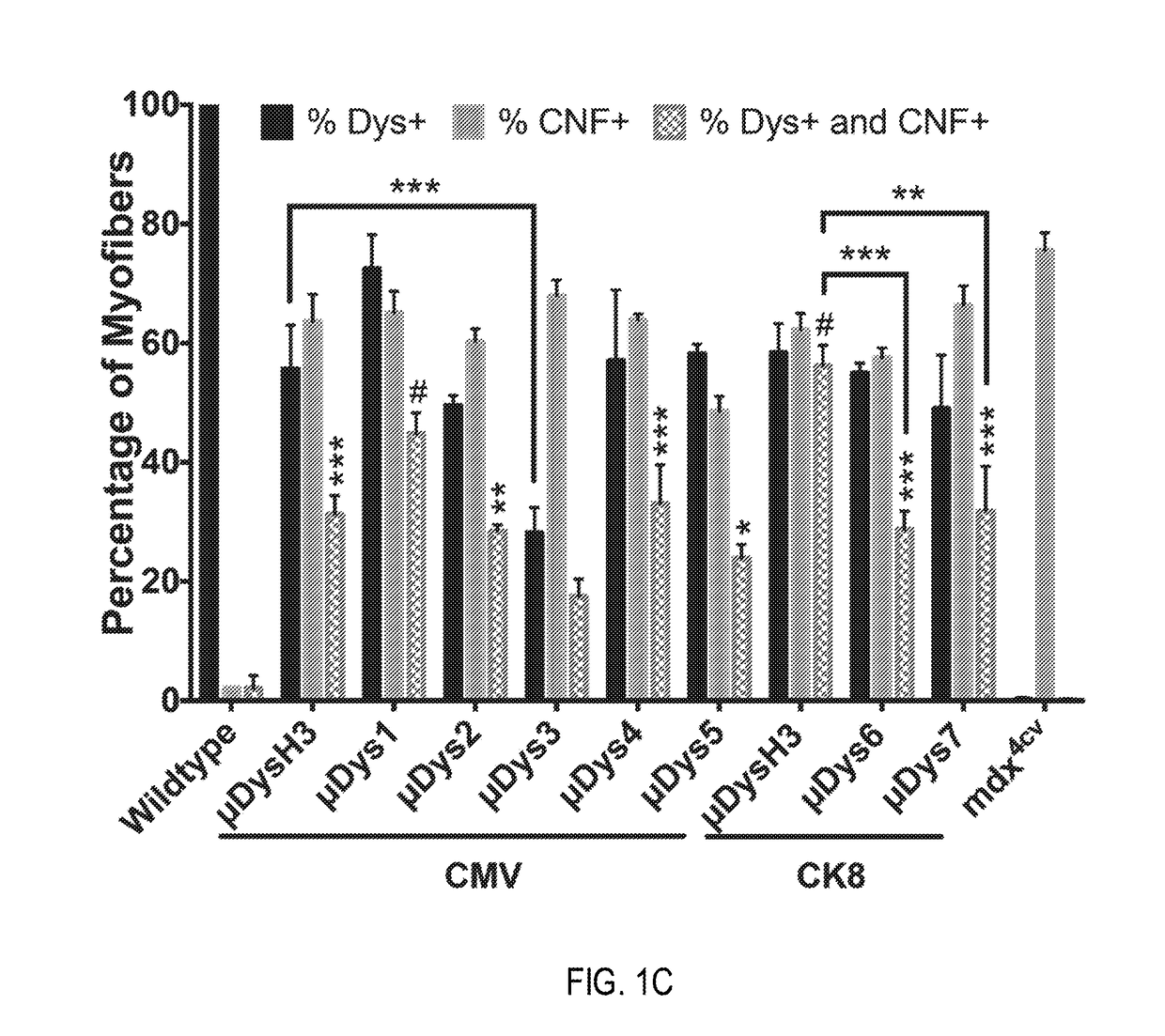Novel micro-dystrophins and related methods of use
a micro-dystrophin and micro-dystrophin technology, applied in the field of micro-dystrophins, can solve the problems of dmd pathology, unable to slow down, loss of ambulation, etc., and achieve the effects of reducing the risk of developing, reducing the test time of 6 minutes, and increasing the average myofiber diameter
- Summary
- Abstract
- Description
- Claims
- Application Information
AI Technical Summary
Benefits of technology
Problems solved by technology
Method used
Image
Examples
example 1
nt of Micro-Dystrophins
[0216]To develop micro-dystrophins with improved performance a variety of structural modifications of the dystrophin central rod domain, which accounts for approximately 80% of the coding region, were assessed. Novel constructs were generated that comprise unique combinations of between four and six of the 24 spectrin-like repeats (SRs) present in the full-length protein as well as the presence or absence of internal hinge domains. These novel micro-dystrophins were evaluated by rAAV-mediated delivery to dystrophic mdx mice followed by pathophysiologic analysis of skeletal muscles after three and six months.
[0217]Several versions of μDys clones were designed with a focus on increasing functional activity while allowing more complete restoration of the dystrophin glycoprotein complex (DGC). The designed μDys clones were compared with a previously characterized ΔH2-R23+H3 / ΔCT clone, μDysH3, which can be highly functional in striated muscles of mdx mice (see Bank...
example 2
Micro-Dystrophin Clones
[0218]Seven novel micro-dystrophin (μDys) clones were designed to test variations of the rod domain structure. Each of the seven micro-dystrophin clones retained coding sequences for the N-terminal actin-binding domain (N-ABD) and the dystroglycan-binding domain (Dg BD), however, each μDys clone incorporated novel combinations of SR and hinge domains, with a goal of generating μDys clones with improved functional properties that may be delivered and expressed from an rAAV vector. Each of the μDys clones were also tested in a mouse model for Duchenne muscular dystrophy (DMD), as described below. The SEQ ID NOs of the amino acid sequences and nucleic acid sequences of μDysH3 and these seven novel μDys constructs are listed in Table 1.
TABLE 1Micro-dystrophin Construct SequencesMicro-dystrophinAmino AcidNucleic AcidConstructSequenceSequenceμDysH3SEQ ID NO: 3SEQ ID NO: 11μDys1SEQ ID NO: 6SEQ ID NO: 12μDys2SEQ ID NO: 7SEQ ID NO: 13μDys3SEQ ID NO: 8SEQ ID NO: 14μDys4...
example 3
lity of Partial Spectrin-Like Repeats can be Dependent on the Rod Domain Composition
[0221]An initial functional screen of μDys clones 1-7 was made in comparison to the μDysH3 clone by generating rAAV6 vectors regulated by the CMV promoter. A dose of 5×1010 vector genomes (vg) was intramuscularly injected into one tibialis anterior (TA) muscle of 5-6 week old dystrophic mdx4cv male mice (see Chapman, V. M., et al., Proceedings of the National Academy of Sciences of the United States of America 86, 1292-1296 (1989)), with the contralateral muscle serving as an internal negative control (N=4-5 mice per construct).
[0222]Dystrophin expression and central nucleation, a hallmark of degeneration / regeneration, was measured at 4 weeks and 12 weeks post-injection (see FIGS. 1C and 1D) to determine how well each construct was expressed, whether expression persisted, and whether the constructs were able to prevent or reduce ongoing myofiber necrosis. All constructs generated μDys proteins of the...
PUM
| Property | Measurement | Unit |
|---|---|---|
| Fraction | aaaaa | aaaaa |
| Level | aaaaa | aaaaa |
Abstract
Description
Claims
Application Information
 Login to View More
Login to View More - R&D
- Intellectual Property
- Life Sciences
- Materials
- Tech Scout
- Unparalleled Data Quality
- Higher Quality Content
- 60% Fewer Hallucinations
Browse by: Latest US Patents, China's latest patents, Technical Efficacy Thesaurus, Application Domain, Technology Topic, Popular Technical Reports.
© 2025 PatSnap. All rights reserved.Legal|Privacy policy|Modern Slavery Act Transparency Statement|Sitemap|About US| Contact US: help@patsnap.com



